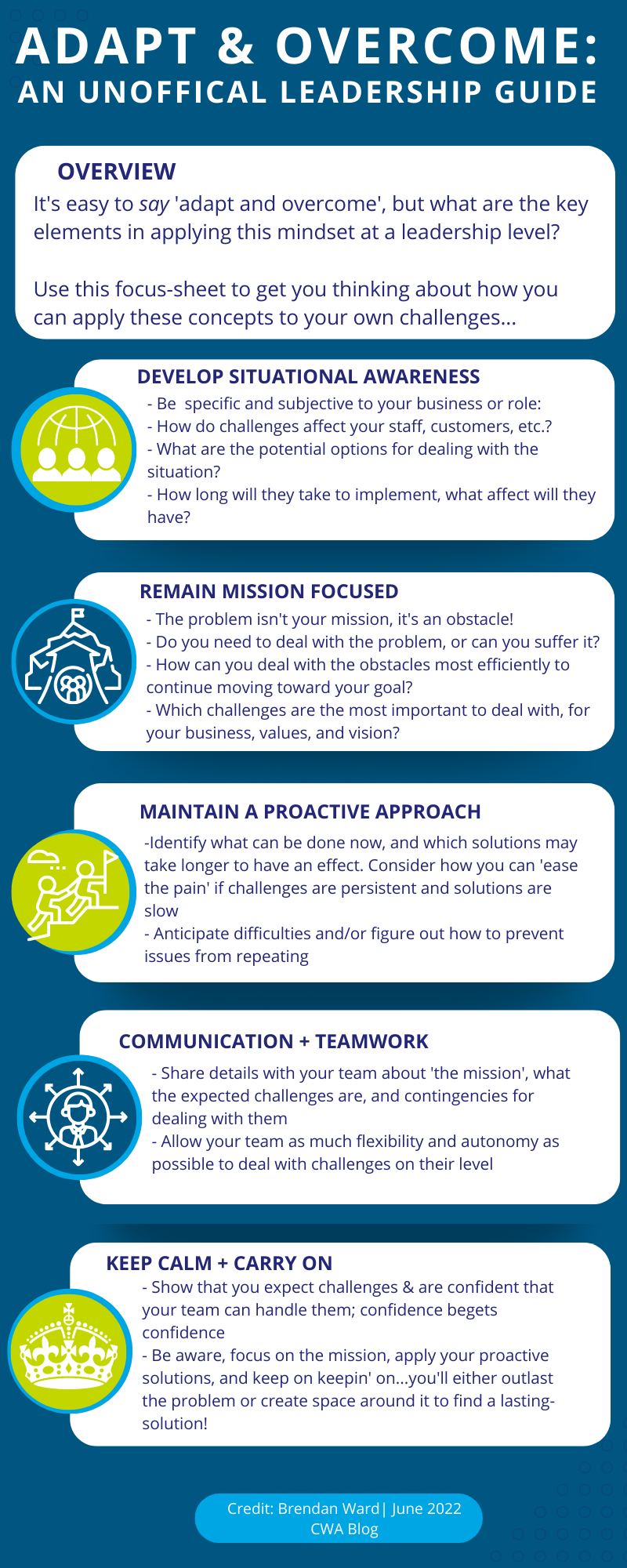Learn How to Adapt and Overcome in the Indoor Climbing Industry

The past three years have presented a litany of big-picture, global circumstances that conspired into a perfect storm of challenges affecting the indoor climbing industry. Chief among them: staff shortages.
Not to mention, of course, the global pandemic, growing anti-work sentiment, Cold War-era geopolitical conflict, socio-political upheaval, global warming...the list seems endless.
There are a lot of ‘above my pay-grade' sort of challenges to contend with right now, and I’ve heard a lot of necessary discussions and reasonable big-picture solutions that have been theorized to deal with current challenges, as they relate to the indoor climbing industry.
But there is often a bit of a void, a time delay at the very least, between discussions, theories, and practical, on-the-ground, positive outcomes. There are always big-picture issues and long-term solutions – but your staff and community (the folks on the front line) need immediate remedies, even if the patches are short-term.
Support your staff and community now by using the ‘adapt and overcome’ strategy to deal with challenges in the moment.
Dealing with serious challenges, consistently, and for prolonged periods of time is something that I learned to manage during my stint in the Canadian Armed Forces as a grunt, and over the past couple years, I’ve found myself drawing more and more from that experience.
“Improvise, adapt, and overcome” is a phrase that comes from the U.S. Marines, Clint Eastwood, or Bear Grylls, depending on your pop-culture preferences. It is a common refrain and prevailing mindset in environments where dealing with challenges isn’t optional.
Often shortened to just ‘adapt and overcome’, it’s a motto that I’ve taken and developed into a leadership strategy that helps me deal with problems and challenges head-on, and in the moment.
And the importance of doing so can’t be understated…if you are in a leadership position and are feeling the effects of a staffing shortage (or any challenge your organization may be facing), imagine how it’s affecting your entry-level staff. They aren’t battle-hardened and experienced like you and may not see the solutions on their own or know what the plan is to get out of the situation.
Uncertainty about your near future is a known stress inducer. Militaries around the world use this to their advantage during basic training programs by keeping soldiers completely unaware about what’s coming next…you don’t know when your next day off will be, when this day will be over or what you’re doing today, or even how long this ruck-march you’re currently on will be. Doing this for weeks and months at a time teaches you a lot, but does not make for happy, well-adjusted people.
Don’t inadvertently let your staff or managers turn into stress-tweaked wrecks and leave them hanging, waiting for things to get better.
Your customers have been through a lot as well, and when they come into your facility, they’re looking for a reprieve from their own stresses. If being short-staffed is becoming a common occurrence, your community will feel the impacts on service and quality, and they will likely feel the stress as well.
Succeeding through difficult times is about finding a way to carry on despite challenges, but it doesn’t mean neglecting big-picture or long-term plans.
Adapt and overcome is about addressing immediate concerns while staying focused on your mission, and creating space for planning and time for higher-level solutions
Here is my unofficial guide to the Adapt & Overcome leadership mindset, and some lessons learned from applying it to staffing issues over the pandemic. Check out the focus sheet as well to get you thinking about how to apply this strategy to your own challenges.
Element 1: Develop Situational Awareness
Possessing a working knowledge of the situation at hand is paramount to effective problem-solving. If you don’t know what’s going on, your solutions will be shots in the dark. Be honest and objective in your assessment; small details can make dramatic differences!
Statistics and trends can be informative, but don’t rely on them to tell your story; you can’t use statistics to predict individual, specific outcomes, so don’t assume that every trend is affecting you.
Lessons Learned
- ‘The Great Resignation’ has been reported on in media and commented on in social media to great lengths, and we felt pressure from staffing issues…but what exactly was going on
- When I took stock of what was really happening in the facility I manage, I found that my staffing issues stemmed from public-health mandates and a shifting culture around coming into work sick – this awareness led to a completely different solution than if I didn’t have this awareness of my specific situation.
Element 2: Remain Mission-Focused
Don’t get too distracted and caught -up with problems. The challenges aren’t your mission, they are the obstacles – once you have a good understanding of the situation, refocus on your mission with a better understanding of the path and obstacles ahead.
Lessons Learned
- After multiple closures and relaunches, and various operating limitations over the course of two years, my vision was crystal clear: staff and customers needed normalcy, consistency, and sustainability.
- There weren’t going to be any ‘time-outs’ so that we could regroup after COVID, it’s full steam ahead as we recover and move forward…we needed solutions that would ease the worst pain points right now and we needed to create big-picture solutions that were sustainable in this ‘new normal’.
Element 3: A Proactive Approach
Beyond taking personal responsibility, being proactive in the adapt and overcome leadership sense requires you to act on what you can do now while also considering contingencies.
Even if it does not solve your big-picture problem or address the root cause, don’t be afraid to treat the symptoms if the cure isn’t readily available.
Lessons Learned
- In dealing with staff shortages over the past two years, I recognized that the challenges we faced might be long-term, and so on top of long-term solutions, I worked with my staff to figure out how they were being affected and how we could ease some of their pain-points.
- We created better “what if we’re short-staffed” plans; we remained committed to giving personal time off; we fed the setters more pizza, organized more staff climbing sessions…we proactively worked at keeping morale up.
Element 4: Communication + Teamwork
Good communication enables your team to be proactive. Having good communication with your team includes sharing details about the mission, what the expected challenges are, and contingencies for dealing with them.
There is a famous Canadian military victory, the Battle of Vimy Ridge during WWI, where the Canadians succeeded where other countries had failed in taking a ridge, partly because of one crucial element: they communicated the plan of attack with the soldiers who were actually carrying out the attack, a novelty until then.
Lessons Learned
- The biggest positive shift that I saw in my team’s ability to handle last-minute staffing shortages was when I started communicating our priorities and limitations, along with strategies for specific situations.
- Often, staff were anxious to do well, and the constantly changing dynamics of the pandemic made it difficult for some to feel confident in what exactly to do.
- By communicating more about the situation, the mission, and our approach, my team gained the confidence to operate under those circumstances.
Element 5: Keep Calm and Carry On!
Endure the challenges, hopefully, made more endurable by your proactive approach, and maintain situational awareness and forward momentum – don’t stop after implementing your first action items.
Kevin Jorgeson said it succinctly in his Keynote Address at the 2022 CWA Summit, “it’s supposed to be hard.” If you expect challenges along your path, they are easier to deal with. Don’t waste time and energy worrying about the existence of the problem, have confidence in both your and your team's ability to handle and focus on the situation.
Your proactive approach can create space around challenges – sometimes just enough space to work on real, lasting solutions or at least to breathe until the challenge passes!
Lessons Learned
- During the pandemic, I was continuously impressed with my team’s ability to take challenges in stride when I communicated well with them and showed them I was confident in our abilities to work through them together.
Download A High-Quality Version of this Checklist

About the Author
 Brendan is a Canada-based climber and a Manager for the Calgary Climbing Centre. He has 10 years of management and leadership experience, and a passion for supporting the climbing lifestyle. With the Rockies as his playground, he is drawn to the incredible ice, alpine, and multipitch lines that define the local landscape.
Brendan is a Canada-based climber and a Manager for the Calgary Climbing Centre. He has 10 years of management and leadership experience, and a passion for supporting the climbing lifestyle. With the Rockies as his playground, he is drawn to the incredible ice, alpine, and multipitch lines that define the local landscape.
